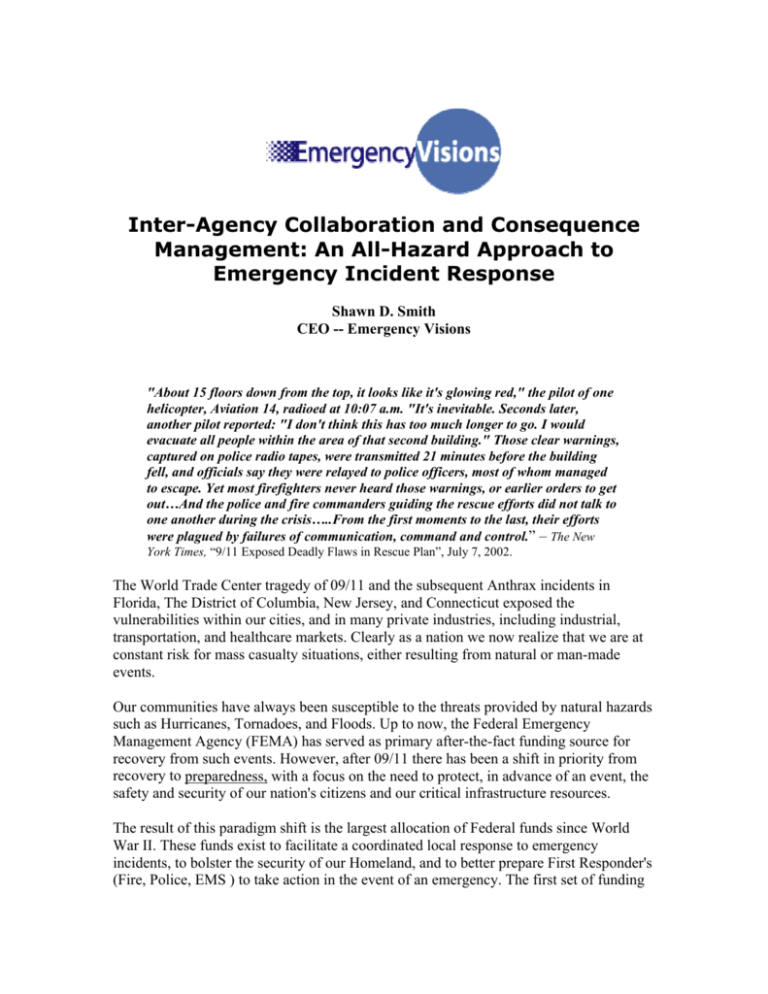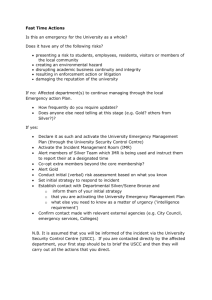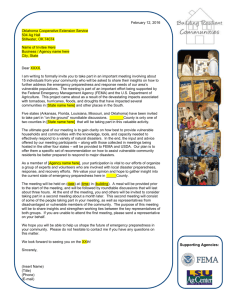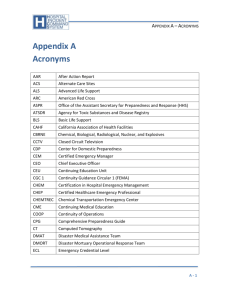Inter-Agency Collaboration and Consequence Management: An All
advertisement

Inter-Agency Collaboration and Consequence Management: An All-Hazard Approach to Emergency Incident Response Shawn D. Smith CEO -- Emergency Visions "About 15 floors down from the top, it looks like it's glowing red," the pilot of one helicopter, Aviation 14, radioed at 10:07 a.m. "It's inevitable. Seconds later, another pilot reported: "I don't think this has too much longer to go. I would evacuate all people within the area of that second building." Those clear warnings, captured on police radio tapes, were transmitted 21 minutes before the building fell, and officials say they were relayed to police officers, most of whom managed to escape. Yet most firefighters never heard those warnings, or earlier orders to get out…And the police and fire commanders guiding the rescue efforts did not talk to one another during the crisis…..From the first moments to the last, their efforts were plagued by failures of communication, command and control.” – The New York Times, “9/11 Exposed Deadly Flaws in Rescue Plan”, July 7, 2002. The World Trade Center tragedy of 09/11 and the subsequent Anthrax incidents in Florida, The District of Columbia, New Jersey, and Connecticut exposed the vulnerabilities within our cities, and in many private industries, including industrial, transportation, and healthcare markets. Clearly as a nation we now realize that we are at constant risk for mass casualty situations, either resulting from natural or man-made events. Our communities have always been susceptible to the threats provided by natural hazards such as Hurricanes, Tornadoes, and Floods. Up to now, the Federal Emergency Management Agency (FEMA) has served as primary after-the-fact funding source for recovery from such events. However, after 09/11 there has been a shift in priority from recovery to preparedness, with a focus on the need to protect, in advance of an event, the safety and security of our nation's citizens and our critical infrastructure resources. The result of this paradigm shift is the largest allocation of Federal funds since World War II. These funds exist to facilitate a coordinated local response to emergency incidents, to bolster the security of our Homeland, and to better prepare First Responder's (Fire, Police, EMS ) to take action in the event of an emergency. The first set of funding allotted has been provided to local communities to facilitate Bioterrorism planning and response efforts (to include incident response for Biological, Chemical, and Radiological Emergencies resulting from terrorist acts). For example, on February 15, 2002, The President's Budget for Fiscal Year 2002 was amended to provide approximately $918 million, directed by the Centers for Disease Control (CDC), to benefit both state and local preparedness and response efforts to potential bioterrorist events, outbreaks of infectious disease, and other public emergencies and health threats of a natural or man-made origin (source: www.cdc.gov , specifically the “Notice of Cooperative Agreement Award, Guidance for Fiscal Year 2002 Supplemental Funds for Public Health Preparedness and Response for Bioterrorism, Announcement Number 99051 – Emergency Supplemental, February 15, 2002”). Unfortunately, even with this new focus on preparedness (and with the associated federal funding becoming available) most private sector organizations, and many communities across the nation, are not adequately prepared for even common emergency situations. Most organizations are not aware of their vulnerabilities or their capacity to respond to emergency situations. Most do not have an accurate or complete set of emergency response plans for the hazards their face. Most have not established polices and procedures for coordination with other agencies in response to an emergency event. And finally, most are not aware of the latest tools and techniques available to disseminate realtime alerts and to facilitate bi-directional communication and messaging between emergency response participants, which would improve preparedness and collaboration. “In virtually every major city and county in the United States, no interoperable communications system exists to support police, fire departments, and county, state, regional, and federal response personnel during a major emergency…Most U.S. cities have separate command-and-control functions for their police and fire departments, and little to no coordination exists between the two organizations.” -America Still Unprepared - America Still in Danger , a Hart-Rudman report sponsored by the Council on Foreign Relations, October 24, 2002 The lack of coordination among agencies is even more evident with respect to Bioterrorism, an event that would involve local and state public health departments. Local Public Health Agencies (LPHAs) have not always been identified locally or nationally as first responders in disasters. Although a public health official is often present at an Emergency Operations Center during a natural hazard response, or a community drill, these agencies are often left out of pre-disaster planning activities. As such, the vast majority of LPHAs lack the expertise and human/physical resources to appropriately assess a community's vulnerability, capacity, and readiness for a chemical or biological incident, or the ability to develop a response plan, and to simulate/drill against this plan to improve the preparedness of the community. Even so, the guidance associated with the CDC funding mentioned above places the LPHA in the role of “Incident Command” for Bioterrorism response. Putting public health in charge of the response to a Bioterrorism event, however, is intentional. The CDC and HHS recognize that LPHAs are uniquely positioned to compile, analyze and disseminate information critical to the public's health, and to a coordinated response to a chemical or biological incident. Most hospitals, for example, are only aware of cases of communicable disease among their own population of patients, and few have direct experience with chemical exposures. Many other agencies (with the possible exception of fire, police, and EMS) are not often aware of the appropriate protocols for treating victims of a chemical incident, and Public Health is likely to be the community's only center of expertise for the clusters, trends, and recognizable patterns inherent to significant disease outbreaks . Information sharing and inter-agency coordination is clearly needed to facilitate a successful emergency incident response. Yet many public and private organizations lack the comprehensive emergency response plans that define the roles and responsibilities of trained personnel responding to an unexpected incident, and describe how to work “sideby-side” with responders from other agencies. Training itself is an issue, as many organizations do not know where to turn for assistance regarding emergency preparedness, nor do they have the time to stop the daily task of operating a business or service to educate personnel on how to respond to disasters, or to implement the emergency preparedness and response requirements now mandated by the federal government. In the local communities, where such training is mandated, agencies participating in an emergency response are typically not coordinated in their efforts, and to make matters worse, severe shortages exist in the area of emergency management personnel. The preparedness and response expertise reflected in this type of human capital is in great demand post-09/11, but very hard to find. Clearly the response to a Bioterrorism incident would be improved with better collaboration and coordination among the agencies and private companies participating in this response effort. How is this accomplished? With training on the principles of Emergency Management and the Incident Command System (ICS) established by FEMA for use in response to any type of hazard (an all-hazard approach), and the implementation of “inherently safer technologies for improved incident response”, advocated by the Department of Homeland Security in recent legislation (source: www.dhs.gov ). The all-hazard approach has been a cornerstone of FEMA's response program since the agency was first established. It integrates the various emergency plans and activities into a "life cycle" of Mitigation, Preparedness, Response, and Recovery (the principles of Emergency Management) and, when combined with the Incident Command System, provides a template for inter-agency coordination that is directly applicable to events stemming from chemical and biological hazards, and all other man-made or natural events. Each and every community with an Emergency Operations Center has “in-house” expertise on the all-hazard approach which should be utilized to assist other agencies (such as public health) in their assessment, planning, and simulation of a communitybased response to emergency situations. Each and every year, 103 cities across the nation demonstrate that collaboration between agencies, coordinated by emergency managers and using the all-hazard approach fully prepares the community for a coordinated incident response. This example refers to communities that are within a ten (10) mile radius of a nuclear power facility, where Radiological Emergency Preparedness (REP) exercises are performed. Horizontal communication and rapid exchange of information among agencies is a basic requirement during any emergency, and the all-hazard approach has proven to be a successful response system for both natural and man-made events. Each community should leverage their experience and knowledge of the all-hazard response system, and ensure that all agencies participating in an emergency incident response are cross-trained in this approach. So what else would help our nation's communities and private sector organizations to better prepare for the threats that we face on a daily basis? The Department of Homeland Security was mentioned above as having legislated the use of “inherently safer technologies” in response to emergency situations. It is, indeed, true that technologies exist that, had they been utilized, would have made a dramatic and positive difference in the overall preparation for, and response to, 09/11 and the subsequent Anthrax incidents. What technologies would qualify for funding by Homeland Security awards and make an immediate difference in a community-wide response to a natural or man-made emergency? Clearly there are a lot of vendors making announcements in today's marketplace on technologies related to Homeland Security, from Chem/Bio decision aids for First Responders to Syndromic Surveillance and Health Alert tools, to mobile command centers filled with sophisticated communications equipment. There is no question that these products add value and individually can improve a part of the overall incident response. However, it is in the area called “Consequence Management” where new technologies can really make a difference in the way a community responds to an emergency situation: The events of September 11, 2001, launched this country on a rigorous and resolute examination of its ability to protect its citizens and better prepare its emergency responders for any kind of emergency or disaster, including acts of terrorism. As we learn from the lessons of that fateful day and work to become better prepared, we must continue to enhance the response systems and processes that have worked effectively in hundreds of emergency situations and disaster operations over the years. Our approach is all-hazards and our priorities are establishing a nationwide mutual aid capability, a common command and control system, baseline capability assessments and national standards, support of state and local emergency management and responders, citizen preparedness, and coordination of federal preparedness programs…Meanwhile, we will continue to look to our federal, state, and local partners nationwide to help us build systems to respond effectively to all hazards. - Bruce Baughman, Director, Office of National Preparedness, Federal Emergency Management Agency (FEMA), January 15, 2003 The solution to our Nation's lack of preparedness is described above by Bruce Baughman of FEMA, and is commonly referred to as “Consequence Management”. This is an emergency management function that includes measures to protect public health and safety, restore essential services, and provide emergency relief to governments, businesses, and individuals affected by the consequences of a natural or man-made hazard. Consequence Management is based upon the Emergency Management principles of Mitigation, Preparedness, Response, and Recovery defined by FEMA back in the 1970s with the creation of the Federal Disaster Response Plan (source: www.fema.gov ). True Consequence Management provides not only heightened preparedness for potential disasters but also focuses on improved emergency response and constant, consistent actions that mitigate the risk of emergency incidents. FEMA further defines the components of a Consequence Management solution as the following: Assessment Tools • • Hazard Vulnerability and Emergency Readiness Assessments Human and Physical Resource Catalogue (Response Participants) Planning Tools • • Customized, Hazard-specific Contingency Plans for Emergency Response Pre-built Standard Operating Procedure Templates / Checklists Communication & Alert Tools • • Risk Surveillance and Event Prediction Real-time Alert Dissemination with Chain of Command Notification Medical Response Tools • Syndromic Surveillance tied to Point of Care/Incident Clinical documentation C4I Tools • Command, Control, Communication, Coordination & Information The above components combine to form a solution that provides Hazard Vulnerability and Emergency Readiness Assessments for any type of emergency (an All-Hazard approach) followed by Response Plans jointly developed by government and industry (Mutual Aid), improved Alert Dissemination and Communication leading to coordinated medical response and overall incident command and control, with a focus on improving the preparedness and response efforts of First Responders (firefighters, policemen, and emergency medical technicians) and local Emergency Managers (trained incident commanders who typically manage the Emergency Operations Center that resides in each community). The need for a complete consequence management solution to better prepare for, and respond to, natural and man-made emergencies is clear. There are numerous and meaningful, measurable benefits to improving command, control, communication, and coordination within each community for all-hazard emergency situations, the number one benefit being the saving of lives. Several different software automation tools are now emerging on the market to support the planning, coordination, and response of local governments and private sector organizations to potential emergencies. These solutions include the latest in event prediction, community-wide physical and human resource identification, automation of contingency plans, real-time inter-agency communication, and overall incident response task workflow and management. Consequence Management technologies serve to help our communities establish control over their resources, effectively plan for emergency situations, and improve the appropriate response to an event, thereby mitigating risk and saving lives. So what overall functionality should a true Consequence Management solution provide? 1. Event Prediction and Alerts (real-time polling of resource status, availability and location, and rapid risk communication/alert dissemination to key personnel as part of a Simulation/Drill exercise, or prior to an actual event) • Monitoring of multiple information sources for possible alerts to response participants (via existing external system interfaces) • Rapid risk communication and alerts regarding an identified threat (reaching response participants via email, fax, phone, Internet, cellular, wireless, and handheld connectivity and connecting with existing information sources, including EOCs, Fire, Police, EMS, e911, Hospitals, Public Works, and even Federal/State agencies) • Pre-event polling of physical and human resources (status, availability, and location) 2. Contingency Planning (identification of physical and human resources by type and workflow, threat response planning, graphical design of response plans, and automation of resource and response plan templates/checklists), • Human and Physical Resource Inventory Automation and Cataloguing • Pre-built Response Templates / Checklists (Natural and Man-made Hazards) • Response Template / Checklist Design Tool (to create custom templates) • Public / Private Sector response communication and coordination 3. Consequence Coordination and Response (actual deployment/coordination of resources during an event, rapid risk communication/alert dissemination to response participants, activation of response plans, prompts to users for specific actions, embedded escalation of alerts and prompts, and full audit/documentation of actions taken by participants during the event) • Real-time polling of physical or human resource status, location, and availability • • • • • • • • Real-time Alert Facility to human participants with embedded workflow, timers, and escalation options Resource Deployment and Optimization (automated prompts for users to take appropriate actions, and for specific allocation/coordination of resources) Rapid Risk Communication / Alert information dissemination (to the media and the public) Command Center and Control via a graphical user interface (top-level view of the incident with drill-down to specific components of the response – also allows user input regarding response components that may change a component's action within the response, or the overall response template) Real-time suggested actions for all response participants Full audit trail of actual actions performed by response participants All functionality available in a “live” incident response is available in a full response simulation Real-time Event Audit / and “live” Documentation of the entire incident response scenario during the Simulation 4. Post-event Audit / Documentation (including resource optimization, recommendations for future events, actual v. plan reports, and non-emergency coordination such as logistics) • Graphical reports (standard line/pie/bar graphing tool) of actual v. plan variances • ESRI mapping (GIS mapping and trend analysis) • Customized regulatory reports (NRC, EPA, CDC, DOT, etc.) • Post-event resource deployment and coordination 5. Simulation and Drill Development (automated, real-time coordination of the critical exercises that can expose gaps in response plans, improve response time, and mitigate risk to actual events) • A Library of simulations (templates) • A simulation development wizard (creating custom drills for multiple threats) • Simulation execution and management (real-time, automated drills with full audit functions by human and physical resource) • Post-drill reports Adopting technologies that improve command, control, and response to emergencies, detect and communicate potential threats, and save lives when a disaster occurs will not only provide day-to-day value in the fight against the emergencies faced by local communities, but they will be also be viewed as an appropriate action to mitigate the risks of the Terrorism threat that all major municipalities currently face. Let's take a closer look at one of the above functional areas: Event Prediction and Alerts. Alert Dissemination is a critical part of an organization's preparedness for an emergency incident, as well as their capacity and readiness to respond. An alert/notification system should include the following features: • Event Prediction: Monitoring of multiple local, state, and national information sources and user-defined risk analysis for possible alerts to response participants • Real-time Alert Dissemination regarding an identified threat or emergency event (including libraried and custom alert messages and message attachments: files, documents, images, etc.) • An Emergency Response Participant Directory (defines how to reach each individual by time of day) based on hazard-specific Contingency/Response Plans or Checklists • A Workflow-based Alert Facility with embedded timers and escalation options to reach response participants via email, fax, phone, Internet, cellular, wireless, and handheld connectivity, and also to connect with existing computer systems, including EOCs, Fire, Police, EMS, e911, Hospitals, Public Works, and even Federal/State agencies • Bi-Directional Communication between response participants (including email, file transfer, instant messaging, communication lists, group messaging, and collaboration/work space options) • A Graphical Message Center offering daily value in the organization and display of emergency and non-related emergency information • A Communications Infrastructure to utilize in the automation of emergency Simulation/Drill exercises • Integrated Voice and Web-based Collaboration/Conferencing tools to facilitate improved post-alert preparedness and response initiatives Event Prediction and Alert Dissemination is a key functional area within the larger concept that FEMA calls “Consequence Management”, and can mitigate the risks associated with emergency situations, better prepare community and private sector organizations for these events, and improve the response to natural and man-made incidents before, during, and after the event. The goal is to minimize the effects of potential disasters, both on an economic and human scale, and as part of a complete Consequence Management solution, Alert Dissemination technologies do exactly that. There are numerous benefits for Local Communities in identifying and implementing a complete Consequence Management solution. Among these are: • Day-to-day value in improved communication between Community agencies • Faster, accurate, more precise Alerts to Key Personnel regarding potential emergencies • Improved preparedness in advance of potential disasters • Better coordination among agencies during the response to an incident • Real-time, accurate information regarding status of human and physical resources responding to an emergency • Optimized deployment, control, and coordination of resources in the field • Full, real-time audit and documentation of actions taken by incident responders • Full documentation of Mutual Aid requests, and the Community response to these requests • Faster recovery from the event • Complete control and coordination of Simulation/Drill exercises to identify weaknesses in emergency response plans by hazard type and to insure full education/preparedness of response participants • Ability to document improvements in incident response over time • A clear indication of positive actions taken to respond to the threat of Terrorism, and to protect the safety of citizens within the community. • Proof of steps taken to improve preparedness for, and response to, virtually any kind of emergency situation • Lives saved as a result of a faster, coordinated disaster response The greatest benefit to local communities will be in the adoption of solutions that can facilitate the overall incident response to any natural or man-made hazard. These Consequence Management solutions will provide numerous, quantifiable benefits for U.S. communities and their Corporate Citizens by mitigating the risks associated with emergency situations, better preparing the community and private sector organizations for these events, vastly improving the response to natural and man-made incidents, and facilitating a smooth recovery from the event. The need for leadership, expertise, and resources in identifying and responding to both natural and man-made threats has become more clearly understood in the aftermath of 09/11 and the Anthrax incidents. The next task for every community, nation-wide, is to define the distinct roles of first responders, the medical community, public health professionals, and all other participants in a community-based response system, to focus on inter-agency collaboration, to cross-train them on Emergency Management principles and the Incident Command System, and to define emergency response plans based on an all-hazard approach. And to do so before the next event occurs. Terrorism does not respect geographic boundaries, and we now know that each and every community in this nation is vulnerable to a terrorist act. We may not be able to prevent these incidents, but we can minimize the effects of these emergencies, as well as natural disasters, both on an economic and human scale with the adoption of technologies that provide Consequence Management solutions, and with a focus on inter-agency collaboration.









